Ancient Ships: The Ships of Antiquity
Anthony and Cleopatra
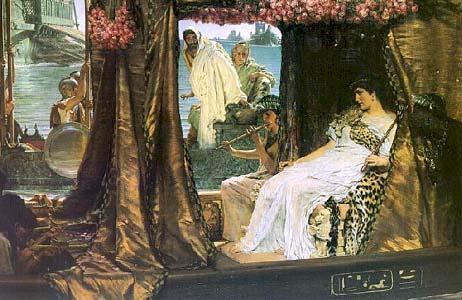
Anthony and Cleopatra
by
Sir Lawrence Alma-Tadema
(Dutch, 1836-1912)
This image is a representation of the Fateful trip of Mark
Anthony and Cleopatra to meet Octavius at Actium in 31 BCE.
The Naval Battle at Actium would forever change the balance of power
in the Roman empire to Octavius favor and lead to the Death by suicide
of Anthony and Cleopatra. This painting shows in great detail
what a Praetorian Galleon must have looked like.
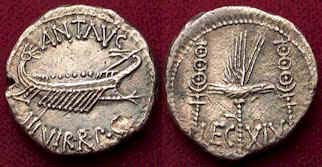
Anthony's naval ships as illustrated on coins
The historic context of these coins
The Antonius Denara was a coin struck as the official coinage of
the soldiers in the service of Mark Anthony during his Rule of the
Eastern Roman Empire. AR Denarius, mint moving with Mark Anthony,
circa 32 - 31 BC.
These denarii exist ed for use by the Legions II - XXIII, as well
as for special elite units such as the speculatores and the praetorian
cohort. This series of coins were struck by Anthony for the use
of his fleet and legions preparing for the struggle with Octavian.
These denarii might be described as a "money of necessity".
The coins image shows a Praetorian galley of Antony's naval fleet.
Reverse: legion Number and - Legionary eagle between two standards

In the year 48 BCE Pompey is defeated by Caesar
and Ptolemy XII of Egypt exiles Cleopatra VII and assumes sole
leadership of Egypt. One year later Julius Ceasar came to the
aide of his mistress, Cleopatra VII and has Ptolemy XII assassinated
and declares Cleopatra the queen of Egypt. Cleopatra marries her
eleven year old brother Ptolemy XIII before leaving for Rome with
Julius Ceasar where she gives birth to a son, Caesarian (later
Ptolemy XIV).
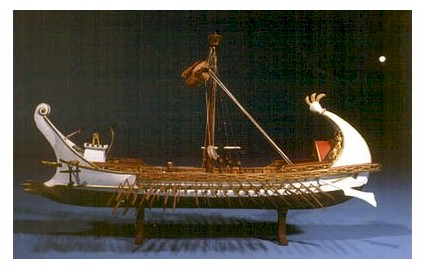 Image Cortesy of the MUSEO TECNICO NAVALE
Image Cortesy of the MUSEO TECNICO NAVALE
In 44 BCE Mark Anthony shares consulship with Caesar and Octavian
and becomes the regent of the Eastern Roman Empire. On march 15th
44 BCE Julius Caesar is assassinated . In Egypt Ptolemy XIII is
poisoned and Cleopatra makes her son, Caesarian her coregent.
In January of 43 BCE Octavian forces the senate to award him the
post of consul, and he changes his name to Gaius Julius Caesar.
In November 43 BCE The Second Triumvirate is formed between Mark
Anthony, Marcus Aemilius Lepidus (high priest), and Octavian
whose power is solidified by eliminating powerful rivals.
In the following year the Second Triumvirate crushes the forces
of Julius Caesar's assassins, Cassius and Brutus. In the Roman empire
Julius Caesar is recognized as a god and Octavian as the "son
of god".
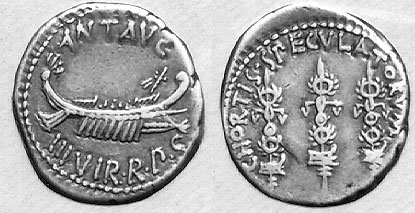
Antony, denarius, 32/1BC, Northern Greece:
CHORTIS SPECULATORVM.
One of the special "Legionary" issues struck for the army
and navy at Actium.
In 41BC the political intrigue increases in the Eastern Empire
when Egyptian queen Cleopatra journeys to Tarsus to explain her
refusal to fully support the Second Triumvirate and Mark Anthony
and Cleopatra fall in love and create their romantic and tragic
political alliance. Mark Anthony and Cleopatra return to Egypt where
Cleopatra gives birth to twins.
This meeting in Tarsus would become part of the legacy and legend
of the city with the story told for centuries afterward. Tarsus
was strategically located to the primary trades routes to the Anatolian
Plateau and therefore a key political center for the Eastern Roman
Empire.
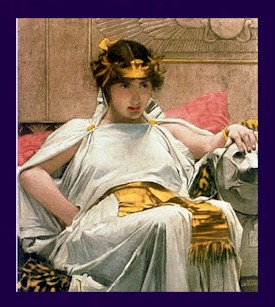
" Cleopatra" By J. W. Waterhouse painted in 1888
The Perusine War begins, between Octavian and Mark Anthony's brother
Lucius Antonius, and Lucius's wife Fulvia. In Rome Octavian marries
Sextus Pompeius's relative Scribonia, an attempt to make solidify
his political alliance with Sextus.
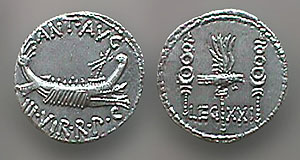
Antony, denarius, ca. 32 BC, Northern Greece: : The typical "Legionary"
issue, struck to pay the troops stationed at or near Actium. Image
courtesy Classical Nuismatic Group
In 40 BCE The Second Triumvirate meet to divide and assign Rule
over the various parts of Roman Empire. Mark Anthony returns to
Rome and marries Octovian's sister Octavia. Then returns to Egypt
and his lover, Cleopatra. In this same year the infamous Herod the
Great is appointed King of Judea by the Romans.
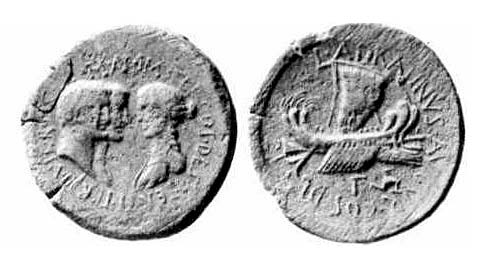
Front: Cojoined heads of Mark Antony and Octavius facing Octavia.
Reverse: Three ships under sail minted in Atratinus Grteece 38 BCE.
The next ten years are marked by various military compagins throughout
the Roman Empire Octavian's navy - lead by admiral Agrippa, defeats
the fleet of Sextus Pompeius. Mark Anthony is defeated in a fight
with the Parthians.
In 32 BCE Mark Anthony is married to Cleopatra, and she gives birth
to another child.
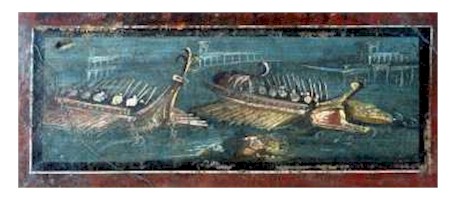
Contemporary illustration of Roman Ships from the walls of Pompeii
70 AD
Antony strained relations between Octavian and himself by divorcing
Octavian's sister, in favor of Cleopatra, Queen of Egypt. Finally,
in 31 B.C.E, war broke out between Octavian and the combined forces
of Cleopatra and Antony. In 31 BC Marcus Antonius and Cleopatra's
joint fleets were anchored in a harbor on the Dalmation Coast of
the Adriatic Sea
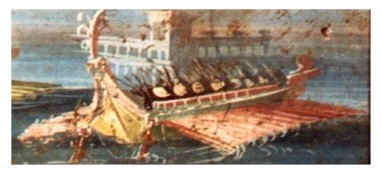
Contemporary illustration of Roman Ships from the walls of Pompeii
70 AD
On 2 September 31 BC, Marcus Antonius' 220 heavily armed fleet
of warships, complete with stone throwing catapults and including
Cleopatra's 60 ships and her treasure ship with purple sails attacked
Emperor Octavian's fleet of 260 ships.
Octavian enjoyed a strategic advantage in the naval battle having
smaller and more maneuverable ships. Historians believe that Marcus
Antonius was easily trapped by Octavians fleet. This is not surprising
considering Marcus Antonius was a soldier and not a naval commander
familiar with the strategies of Naval battles.
Octavian with the defeat of his foes at the naval battle of Actium
became sole ruler of Rome. He returned to Rome in 29 B.C.E and celebrated
his recent victories against Marcus Antonius.
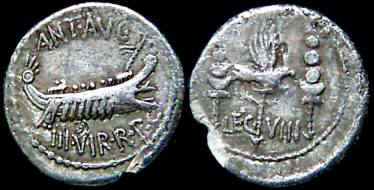
The story ends tragically in 30 BCE when Oct a vius (Emperor Augustus)
attacks Alexandria, where Mark Anthony and Cleopatra commit suicide.
Oct a vian has Cleopatra's son Caesarion is put to death and Egypt
is annexed under the rule of Emperor Augustus' representatives.
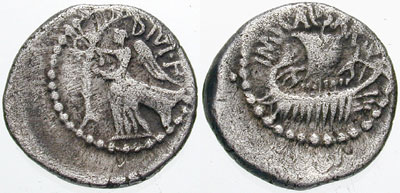
The history and human events of this dramatic story have become
immortalized in the classic Shakespearian play " Antony and Cleopatra"
Octavian Fleet coinage
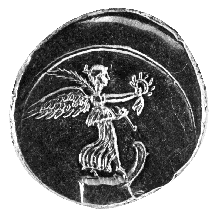
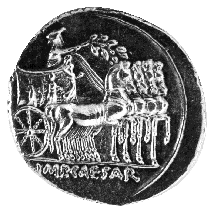
Octavian - AR denarius, 29-27 B.C.
But both the obverse and reverse of this coin feature types referring
to Octavian's victory over Antony and Kleopatra. Victoria on a ship's
prow on the obverse refers to naval victory, specifically Octavian's
defeat of Antony's fleet in the Battle of Actium. But the depiction
of Octavian in a triumphal quadriga on the reverse indicates that
the coin actually dates from his triple triumph (for his victories
in Illyricum and Egypt, as well as in the battle of Actium) in Rome
in 29 B.C., when the Senate conferred numerous honors upon him.
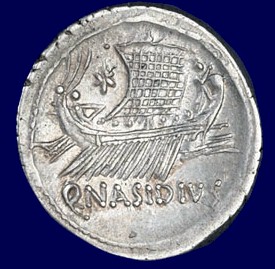
1st Century BC Roman Galleon as depicted on a Roman Coin

2nd Century AD Coin showing Hadrian and Roman Galleon
Previous |
Next |
Table Of Contents
|
